
So you've grooved to the tunes of Airtel's latest ad featuring college students. Here's what went behind the scenes and how the commercial was made!
Sometime in July this year, Agnello Dias, chairman and co-founder of TapRoot India, a Mumbai-based ad agency telephoned director Ram Madhvani.
"Are you free? What's up?" he asked.
Dias is a former JWT man and has worked on the famous Nike ad, and the Aman ki Aasha and Lead India campaigns among others. Madhvani is an award-winning director who made the Happydent ad that won a bronze and a silver lion at Cannes in 2006.
The two go a long way. In fact Ram Madhvani credits him with reinventing his career.
So when Dias asked him if he was free, Madhvani figured there was something exciting in the making.
And yet when the two met up, neither had the slightest idea that they were about to create what is arguably one of the most talked-about commercial of the year.
By the second week of August they had shown it to Sunil Mittal, the founder, chairman and Group CEO of Bharti Enterprises.
After watching the video, Mittal said, "Let's take it on air."
There were no cuts, no changes, no extra suggestions.
So just like that, on August 18, Airtel's latest commercial was launched.
Within days, the ad featuring practically no known face, went viral.
The ad has a catchy score, a great script and a bunch of 70 young actors -- some of them still students -- exuding tremendous energy from shot one.
It's impossible to miss the ad -- it's everywhere. If you haven't watched it on television, it's probably there on your Facebook wall or Twitter timeline.
This is the story of how it got made.
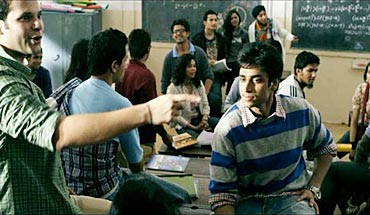
Based around Dias' campaign line: 'Har friend zaroori hai yaar!' the concept of the ad is that unlike in the past, one has a lot more friends today.
"Earlier you had school friends, college friends and work friends. Today you have friends you don't meet at all -- like Facebook friends for instance or friends that are in touch with you only on SMS or email. The idea was to design a campaign around each of these 'types'," Dias says.
When he made his first presentation to the client and creative folks at Equinox films, he divided them into three broad categories.
"The first category has friends who're bound by the technology they use (like BBM, Twitter, Facebook, MMS or SMS).
The second are bound because of the common interests they share.
And the third are the friends who we categorise according to how we use them -- so my 3am friend needn't be a 3am person otherwise or a friend who I borrow money from may not be a lender to everyone."
Dias, Madhvani (who directed the film), Manoj Shroff (the producer) and Amitabh Bhattacharya who wrote the lyrics brainstormed around the concept.
"Once Amitabh wrote the song we tweaked it around a little bit. For instance after the line 'Chaddi buddy, joke buddy' we made the actors say 'kuttey' and 'kaminey'. That was not part of the original song.
It broke the monotony of the song and suggested that whatever one may achieve in life, bonds of friendship won't change."
Interestingly while both Madhvani and Bhattacharya were quite okay with the idea of having colloquial slang in the commercial, Shroff who was producing the film was not entirely comfortable.
"I didn't know how it would go down with the audience," Shroff says.
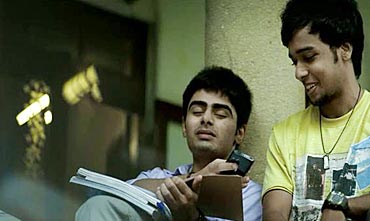
Ram Madhvani says, "The idea was to give the campaign a feature film scope.
Imagine if this were a trailer for a film. You would have got into the lives of these people.
They should exist before and after the ad's duration. What you see on the screen should just feel like snippet out of their lives."
So Madhvani and Dias gave most of the characters in the film a back story.
Dias points out, "Take the instance of the six girls crashing at the boy's place. They were probably partying late into the night and couldn't go back to their homes or PGs.
Or the part where one guy has broken his leg and his friend is taking him to the hospital, talking to someone, presumably his parents, assuring them their son was fine.
The three guys on top of a bus sharing a blanket have probably bribed the conductor and are heading to some place out of town.
If you look at the ad you'll realise that for every single shot there is an implied story."
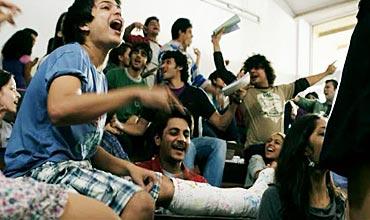
Unlike in many ad films where the writer gives the lyricist the script and asks him/her to write a jingle, the entire process -- from casting to writing the script and lyrics and directing -- was what Madhvani and co like to call 'an organic process'.
He says, "There were a lot of ideas that went back and forth. We needed a structure -- a proper beginning, middle and end.
One of the challenges was to figure out the various situations (we would show in the film). We had a lot of suggestions from people within the team.
Some we picked from our lives -- like the last one where the boy pulls a fast one by announcing 'Principal!' was something I did when I was in school.
Another one -- where the two girls are wearing the same t-shirt -- came from a questionnaire we had sent out to some of my son's college friends.
All in all, it was entirely Aggie's (Agnello Dias) script. The idea was his but he was as always open to suggestions.
At the end, we had about 25 situations."
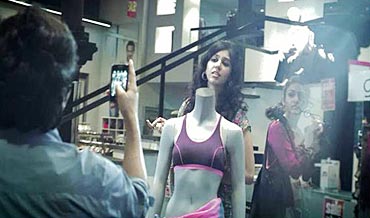
The other issue that Dias and Madhvani were faced with was to make sure that visuals for the situations don't look clich d.
Dias recollects, "We did not want them to be obvious and straightforward so we kept rejecting a lot of ideas.
For instance for the part where the jingle goes: 'Koi raat ko teen bajey jaan bachaye' we could've shown a friend on the phone counselling another one over a broken love affair. Rather we chose to have a friend rescuing someone from the police station for what must have been an obviously minor offence.
Similarly, rather than showing a boy carrying some 50 bags in the 'shopping mall wala friend' we went for something naughtier and showed him taking a picture of his (girl) friend behind a bikini-clad mannequin.
At some places of course, we kept it simple -- like the 'exam hall wala friend' part, which had a straightforward visual (of a boy copying)."
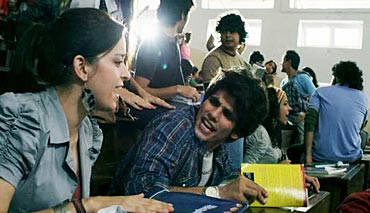
Amitabh Bhattacharya, best known for Emosanal Atyachaar and more recently Bhaag DK Bose, has written the lyrics for this one.
Like everyone else associated with the ad film, Bhattacharya too credits Agnello Dias for its success.
"The credit goes to Agnello. After he briefed me about the idea I returned with the first draft the next day.
When you have a brief like (the one Agnello gave) mine becomes the smallest job!
A week later (after some tweaking around) the final draft was ready."
Once the lyrics were finalised, the team approached Ram Sampath to compose the music. Sampath, like the others, has been an old industry hand.
He has worked with Dias on the Nike ad and has to his credit the Sony Ericsson 'Thump' sequence to which Hrithik Roshan danced.
The brief given to Sampath was simple -- he should only use those sounds that could be created in a classroom and give it a canteen anthem feel.
So if you hear the ad carefully, all you can hear is thumping of books and desks, clapping of hands and a sound that resembles the beating of a dustbin.
"Ram would have come up with an even better score had we let him use the (musical) instruments of his choice. The ad would have been far more musical but wouldn't have had the fresh feel it has now," Madhvani says.
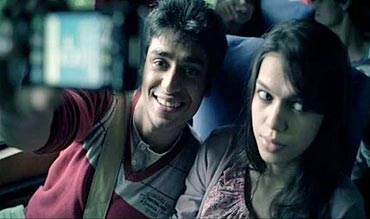
While Dias and Madhvani were getting excited about shooting the ad, their producer Manoj Shroff was beginning to get worried.
It was the peak of monsoon and the unpredictable Mumbai rains could easily put the shoot off gear. Also, 25 situations meant as many locations.
Then there was the 'little issue' of getting 70 actors and convince the audience that these unknown people were all classmates and great friends.
This is where casting director Abhimanyu Ray stepped in.
Ray, who has been a casting director for movies such as Rocket Singh Salesman of the Year and Teen Patti among others, was also associated with the recent 'Blackberry Boys' advertisement for Vodafone.
"I did not want typical models (for the job). I wasn't as interested in how they look as I was in their acting skills because each sequence was under two seconds and their faces would be flashed for just that little a time. So we were extremely specific about what parts each of them would play," Ray says.
Usually one approaches modelling agencies to source for actors but Ray himself boasts of a huge database of models who he auditions regularly for various ad films.
So Abhimanyu Ray went through over 200 audition tapes, zeroed in on about 100 and finally Madhvani selected about 70.
***
Ram Madhvani adds, "We wanted to make people (in the ad) look like they actually exist. So we called (all the actors) a few days before we started shooting.
For the first four hours or so we did a few theatre exercises. This helped them shed their inhibitions and helped them to get to know each other.
In the second half of the day, we rehearsed and got them to sing the jingle over and over again.
So by the time they were on the set they had known the song, and they had intuitively bonded with each other.
Ram (Sampath) was also there. So even though he'd recorded the jingle, he managed to get some extra sounds.
The other thing that this exercise helped us in was to figure out what person is good for which scene."
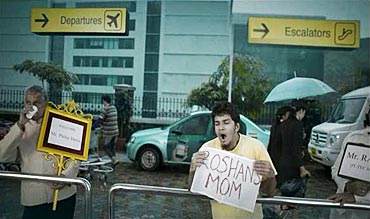
Finally, it was time to shoot -- across various locations in Mumbai for five days between July 28 and August 2.
Hemant Chaturvedi who was the cinematographer for Maqbool, Company and Kurbaan was shooting the ad.
Thanks to a location manager, Mahesh Tawde, another of Madhvani's old time co-worker, the locations were zeroed in on.
The classroom scene was shot in Sophia College in South Mumbai from 4pm to almost 9.30 pm. So it had be lit up artificially to make it look like it was daytime. The idea of shooting in Sophia College was because its amphitheatre-like design helped Madhvani to choreograph better. Unlike a flat classroom would've made it difficult to focus on the actors who'd all be at the same level.
The police station was a real one in Gamdevi, not very far from Mani Bhavan but a small restaurant next to it became a college canteen where 'gossip ka ghoomta firta satellite' is sharing juicy gossip with his friend.
Three boys freezing atop a bus were not heading to a hill station -- they were very much within the city limits -- at Film City in the western suburb of Goregaon.
An IT park in Goregaon itself was passed off as an airport where a boy is receiving his friend's mother while a part of the furniture showroom in South Mumbai became the room where six girls had crashed after a night out as the host -- a young boy slept on the chair!
A tall building in South Mumbai's Nana Chowk area became the place for the 'movie buddy' as he takes a phone call and sticks his dark glasses on his collar a la Salman Khan in Dabanng while the dilapidated Worli fort in central Mumbai with the skyline (and a hint of the sea-link road) in the backdrop was where three shirtless boys share a joke.
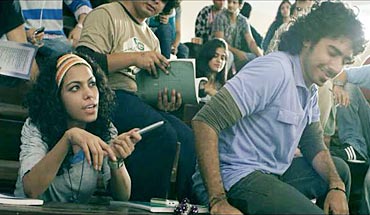
While the shoot went like clockwork -- thanks to Siddharth Luther first assistant director, and Sunitha Ram the line producer -- there was one point when things were threatening to go out of control.
Shiv Sena had threatened to call a Mumbai Bandh on Monday, August 2.
Manoj Shroff recollects, "There was a moment when we were wondering how to reschedule things. Things could have got out of hand. One of our last options was to shoot on Sunday (August 1). At some point we were even talking to politicians to find out if the bandh was on."
Finally the strike was called off and the shoot went off as scheduled.
"We're quite organised," Madhvani says, "In retrospect I think we might've been able to pull this off in four days.
***
Priyanka Chand the model who opens the ad (in pic here) also tells us that they had a blast shooting the movie. Chand, a professional actress and a former RJ says that she just stumbled upon the offer as she'd strolled into the auditions Ray was conducting.
She was noticed because of her curly hair and after a few rounds of auditioning, she knew she'd be on. What she probably didn't know was the response she'd get after the ad went on air.
Chand has been flooded with calls -- congratulating her and inviting her for auditions.
"My Facebook friends who don't usually talk to me now make an effort to say hello," she gushes.
Her eventual plan is to get into films, which she knows will be quite difficult. She tells me she has completed a television show for a yet-to-be launched channel by the Adhikari Brothers and will be seen in a cameo in a Kunal Kohli film and yet another made-for-television film for MTV India.
Chand says that she has never really been in the ads circuit and this was probably one of the few times she actually did it. Needless to say, she isn't regretting.
The jingle itself has become a part of public lingo.
Ram Madhvani has been flooded with calls and congratulatory text messages. Some of his more creative friends have even created their own versions of the song.
He forwarded me a couple -- one of them is a funny take off on bosses and the other, a cheekier one goes 'Har ek peg zaroori hota hai!'
"What's amazing is," Madhvani texts, "is how much it's became a part of the lives of the people."